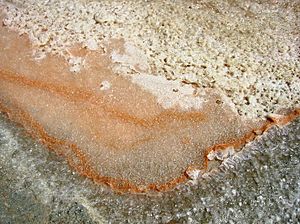Halophile facts for kids
Halophiles are tiny living things that need salt in their environment to survive. The word "halophile" comes from Greek and means "salt-loving." You can find halophiles in places like salt lakes, such as the Great Salt Lake or the Dead Sea, and in ponds where salt is collected as water evaporates.
Most halophiles are a type of tiny organism called archaea. But some bacteria and even some eukaryotes (like the green alga Dunaliella salina) are also halophiles.
Contents
How Halophiles Survive in Salt
Imagine a sponge in water. If the water around it is very salty, the water inside the sponge will try to move out to balance the saltiness. This process is called osmosis. For most living things, if they are in a very salty place, they would lose all their water and dry up.
Halophiles have special ways to stop this from happening. Their insides (called cytoplasm) need to have the same saltiness as their surroundings. They do this using two main tricks:
Storing Special Compounds
One way halophiles survive is by keeping special organic compounds inside their cells. These compounds act like a shield, protecting the cell from losing water. They are often amino acids or sugars.
This method is good because it lets halophiles live in many different levels of salt. Also, the important parts of their cells (like proteins) don't have to get used to super high salt levels. But this method uses a lot of energy!
Pumping Ions In and Out

Another trick is to pump certain charged particles, called ions, in and out of the cell. They mostly pump potassium (K+) ions into their cells. At the same time, they pump sodium (Na+) ions out. This is done with a special "pump" in their cell membrane.
This method uses less energy than the first one. However, it means that all the cell's internal parts, like enzymes and other proteins, must be able to work well even with lots of salt inside. This is a big challenge for the cell.
Most halophiles use only one of these two methods, but a few can use both!
Types of Halophiles
Scientists group halophiles based on how much salt they need to grow best.
Slight Halophiles
These halophiles like a little bit of salt, usually around 2% to 5%. That's about the same saltiness as seawater. You can find them in ocean mud or even garden soil. An example is Erythrobacter flavus.
Moderate Halophiles
These halophiles prefer more salt, from about 5% to 20%. They live in places like salt lakes or at the bottom of the sea. Some examples include organisms from the groups Desulfovibrio and Desulfocella.
Extreme Halophiles
These are the true salt-lovers! They need a lot of salt, from 20% to 30%, to grow. They live in super salty places like the Dead Sea or special ponds used to make sea salt. Salinibacter ruber is an example of an extreme halophile.
Why Halophiles Are Important
Halophiles are more than just tiny salt-loving creatures; they play important roles in nature and for humans.
Halophiles in Nature
Halophiles are a key part of many ecosystems. For example, they can be a food source for large groups of wild birds.
They can also help clean up pollution. If water is salty (more than 2% salt), halophiles can help remove harmful chemicals from it. For instance, they can get rid of phenol, a poisonous chemical. This means they might be used in the future to clean up things like oil spills.
Halophiles in Food Making
Halophiles are important for making some of our foods! They help in the fermentation process for things like soy sauce and fish sauces. They also help ferment salted fish.
Halophiles in Technology
Scientists are very interested in halophiles for biotechnology. These tiny organisms can make special compounds that are not found anywhere else. They also produce enzymes (special proteins that speed up reactions) that can work in very salty conditions. These enzymes could be used in tough industrial jobs, like food processing.
Some moderate halophiles even make sugars outside their cells. These sugars can be used as thickeners or emulsifiers in industries like petroleum and medicine.
Related pages
See also
 In Spanish: Halófilo para niños
In Spanish: Halófilo para niños



